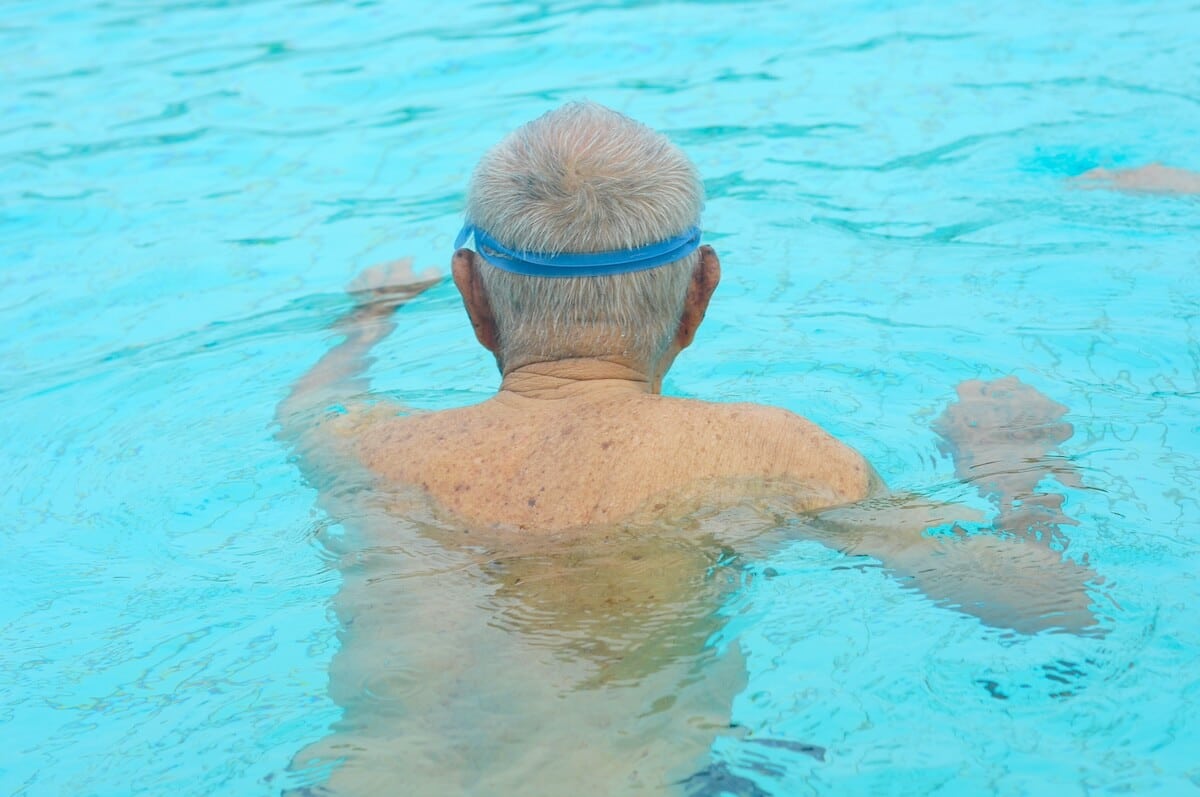Free download: Top 10 Natural & Easy Remedies for Joint Pain from Home. Learn these helpful remedies.
Estimated Reading Time: 8 minutes read
Swimmers’ shoulders are a common issue faced by swimming enthusiasts and professionals alike. This condition, often characterized by shoulder pain and discomfort, can significantly affect one’s performance and overall swimming experience. Understanding how to manage and mitigate these symptoms is crucial for anyone regularly engaging in swimming activities.
Swimming is an excellent form of exercise, but the repetitive shoulder movements can sometimes lead to overuse injuries. Swimmer’s shoulder is particularly prevalent among those who swim frequently or with high intensity. By learning about the causes, symptoms, and management strategies, swimmers can continue to enjoy their time in the pool while minimizing the risk of injury.
Causes of Swimmer’s Shoulder
Before diving into the management strategies, it’s essential to understand the underlying causes of the swimmer’s shoulder. This knowledge can help in preventing the condition from occurring or worsening. Here are some common causes:
- Repetitive Motion: The constant overhand motion of swimming can strain the shoulder muscles and tendons.
- Improper Technique: Incorrect swimming strokes can increase the stress on the shoulder.
- Muscle Imbalance: A lack of balance between the shoulder muscles can lead to instability and injury.
- Overtraining: Excessive swimming without adequate rest can overwork the shoulder.
- Weak Muscles: Weakness in the shoulder muscles can fail to support the joint properly.
- Previous Injuries: Prior shoulder injuries can increase the risk of a swimmer’s shoulder.
Each of these causes contributes to the development of a swimmer’s shoulder in different ways, but they all highlight the importance of proper technique, balanced training, and muscle strength.
Symptoms of Swimmer’s Shoulder
Recognizing the symptoms of a swimmer’s shoulder is critical to timely and effective management. Here are some signs to look out for:
- Pain and Tenderness: Especially around the shoulder joint, often aggravated by swimming.
- Reduced Range of Motion: Difficulty in moving the shoulder as usual.
- Swelling or Inflammation: Visible signs of swelling around the shoulder.
- Weakness in the Arm: Feeling of reduced strength in the shoulder and arm.
- Clicking or Grinding Sensation: Sensations of clicking or grinding during shoulder movement.
- Discomfort during Rest: Pain or discomfort in the shoulder even when not swimming.
These symptoms can vary in intensity and frequency, but they all indicate that some form of intervention is necessary to prevent further injury.
Soft Tissue Mobilization and Stretches
When it comes to managing a swimmer’s shoulder, incorporating soft tissue mobilization and stretches into your routine can be highly beneficial. These techniques help alleviate pain and improve flexibility.
A: Soft Tissue Mobilization
Using tools like a lacrosse ball can be effective in addressing trigger points that might be causing nerve pain. This form of self-massage can release tension in the muscles and improve circulation in the affected area.
To use soft tissue mobilization for Swimmer’s Shoulder with a lacrosse ball, follow these instructions:
- Find the Sore Spot: Locate the tense or painful area in your shoulder.
- Position the Ball: Place the lacrosse ball between your shoulder and a wall or the floor.
- Apply Pressure: Lean against the ball, applying pressure to the sore spot.
- Roll Gently: Move your body slowly to roll the ball around the area, targeting trigger points.
- Hold on Tight Spots: When you find a particularly tense spot, hold the ball there for 15-30 seconds.
- Repeat: Continue for several minutes, then switch to the other shoulder If needed.
B: Stretches
Regular stretching is vital for maintaining flexibility and preventing stiffness in the shoulder muscles. Some recommended stretches include:
1. Levator Scapulae Stretch
- Begin by sitting upright in a chair.
- Depending on the side of pain, place that hand on the seat. For instance, if your right side aches, use the right hand.
- With your opposite hand, gently grasp the side of your head.
- Apply a gentle pressure to guide your gaze toward the opposite armpit.
- Hold for 30 seconds and repeat three times.

2. Pec Stretch

- Standing in front of your doorway, raise your arms up to shoulder height like a goalpost. The elbows will be bent with the palms facing forward.
- Keeping this position, rest the arms against your doorway.
- Slowly lean forward into a gentle stretch and hold for at least 30 seconds.
- Repeat this stretch for a total of 3 times.
3. Book Openers


- Begin laying on one side (you can lay on your bed, couch or the floor). Make sure to have pillow support for a neutral neck position. The legs can be relaxed in whatever position is most comfortable.
- Reach the top arm forward, then slowly begin moving it toward the ceiling. Have the head follow this motion.
- Once the arm is pointing towards the ceiling, the rest of the spine should rotate and follow the arm as it continues to move and stretch behind you.
- Only rotate as far as the spine is comfortable with.
- Hold for 5 seconds, then return to your starting position.
- Repeat for 3 repetitions, then perform on the opposite side.
These stretches target the key muscles involved in swimming and can help in reducing the strain on the shoulder.
Strengthening Exercises for Swimmer’s Shoulder
In addition to stretches, strengthening exercises play a crucial role in managing the swimmer’s shoulder. These exercises help in building muscle resilience and stability in the shoulder joint.
1. Chin Tucks


- You can perform a chin tuck laying on your back or sitting or standing.
- Gently tuck the chin directly back as if trying to make a double chin. Avoid nodding your head.
- Hold this position for 2 seconds, then slowly relax your muscles.
- Repeat 10 repetitions.
2. Scapular Retraction
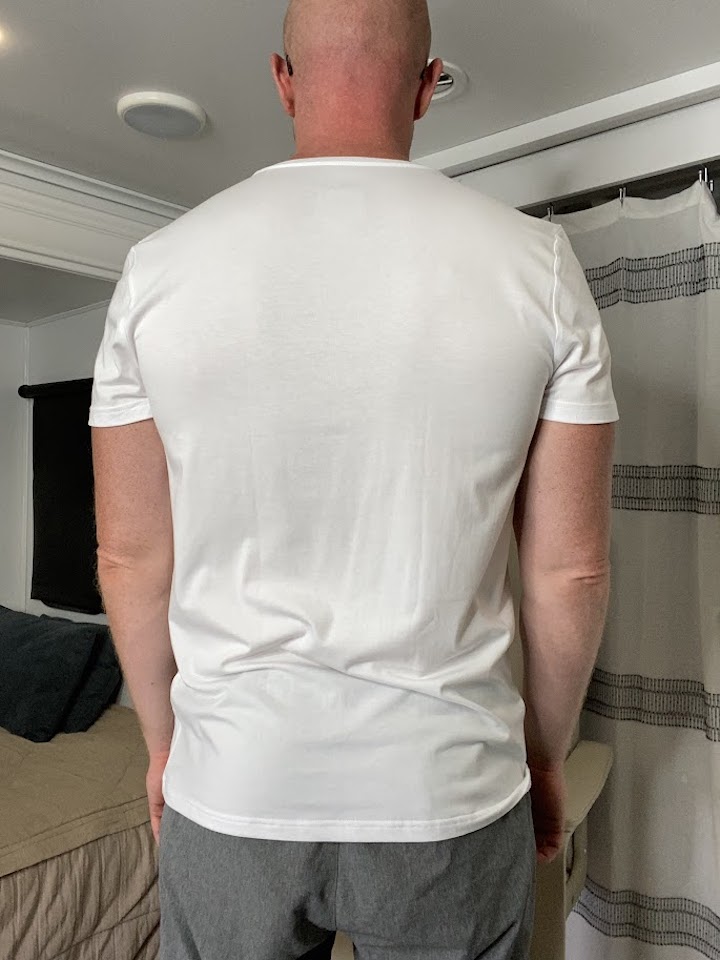
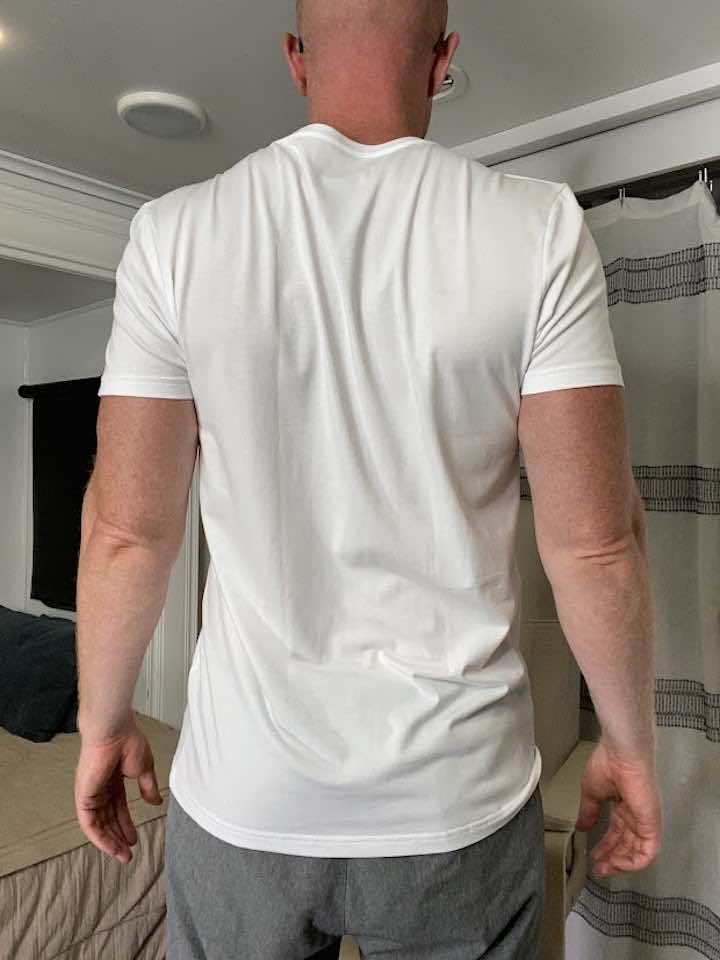
- In a sitting or standing position, try to sit as straight as possible. Aim to position the head in a neutral position as possible.
- Gently pull the shoulders back and squeeze the shoulder blades together.
- Hold for 5 seconds, then relax.
- Repeat 10 repetitions for 3 sets.
3. Rows with Resistance Band

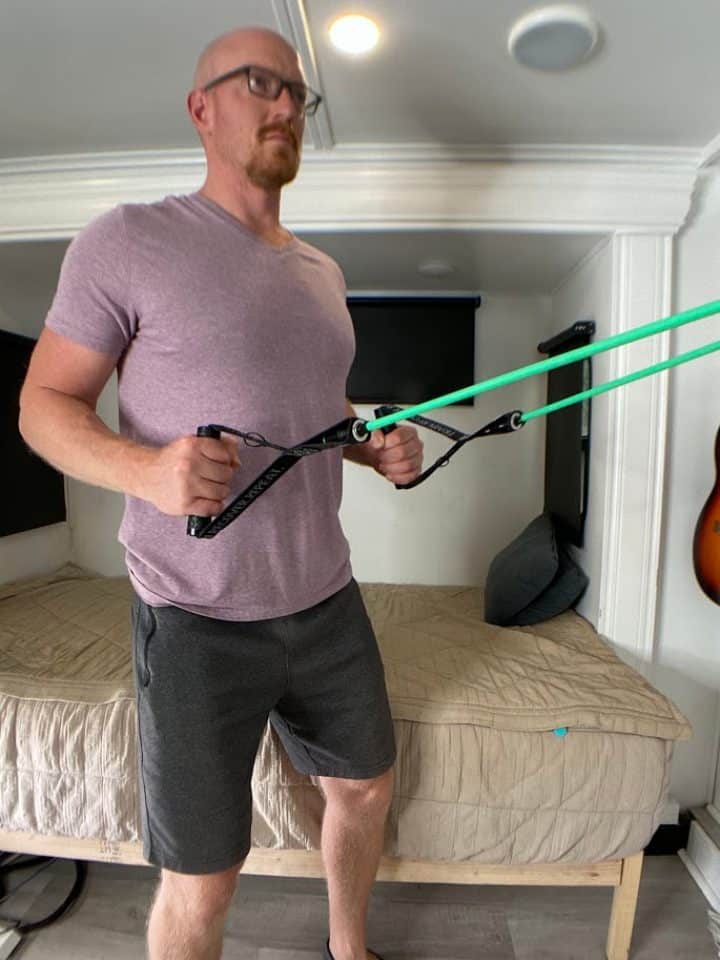
- Hold on to the ends of a resistance band (light, medium or heavy), which you can attach to a door knob.
- Begin with the arms elevated in front of you to shoulder height and the palms facing each other.
- Step back far enough that the resistance bend has a little tension.
- Pull back on the band by bending the elbows and swinging the arms back next to you. Make sure to squeeze the shoulder blades together.
- Hold for 2 seconds, then return to your starting position.
- Repeat 10 repetitions for 3 sets.
4. External Shoulder Rotation with a Resistance Band


- Attach one end of the resistance band to a secure location, such as a doorknob or post, at the height of your elbow to perform the correct motion.
- Stand facing the band and hold the other end with your hand on the same side, elbow bent at a 90-degree angle and tucked by your side, and palm facing towards your body.
- Keeping an upright posture, slowly pull the band away from your body, rotating your arm outward and away from your torso while maintaining the 90-degree angle of your elbow.
- Hold this position for 2 seconds, then return to your starting position.
- Repeat the movement for 10 repetitions, then switch to the other arm.
- Aim for 3 sets of this exercise.
5. Internal Shoulder Rotation with a Resistance Band

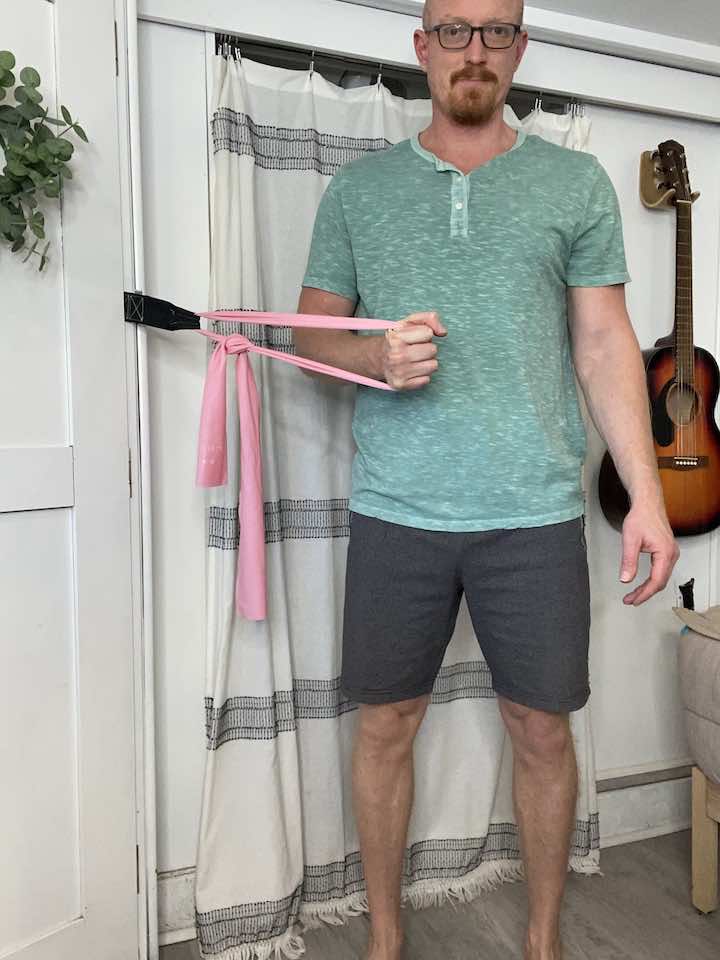
- To perform this exercise, you will need to attach one end of the band to a secure location, such as a doorknob or post, at the height of your elbow to perform the correct motion.
- Keeping an upright posture, slowly pull the band towards your stomach while maintaining the 90-degree angle of your elbow.
- Hold for 2 seconds, then return to your starting position.
- Repeat the movement for 10 repetitions, then switch to the other arm.
- Aim for 3 sets of this exercise.
These exercises are designed to strengthen the muscles around the shoulder, reducing the risk of injury and improving overall shoulder health.
Care Tips for Swimmer’s Shoulder
Taking care of your shoulder is an ongoing process, especially if you’re a regular swimmer. Here are some care tips to keep in mind:
- Regular Warm-Up and Cool-Down: Always start with a warm-up and end with a cool-down session to prepare your muscles for the workout and aid in recovery.
- Balanced Training Routine: Include a variety of exercises in your training to prevent overuse of the shoulder.
- Adequate Rest: Ensure you’re giving your body enough time to recover between swimming sessions.
- Proper Technique: Work with a coach to ensure your swimming technique is correct and efficient.
- Use of Proper Equipment: Invest in good quality swimming gear to support your body correctly.
- Seek Professional Help: If pain persists, consult a healthcare professional for personalized advice.
Implementing these care tips can significantly reduce the risk of developing a swimmer’s shoulder and aid in faster recovery if you’re already experiencing symptoms.
Conclusion
Managing a swimmer’s shoulder effectively requires a combination of understanding the condition, practicing preventive measures, and incorporating specific exercises and stretches. By paying attention to your body’s signals and responding appropriately, you can maintain shoulder health and continue to enjoy swimming.
Remember, prevention is always better than cure, so take the necessary steps to protect your shoulders. If you experience persistent pain or discomfort, seeking professional advice is crucial to avoid long-term injury. Stay healthy and keep swimming!


